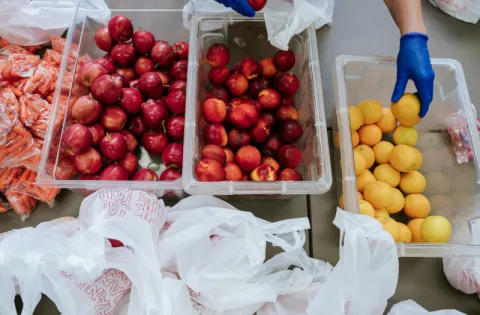When most people think of college students they think of late nights studying in the library, sporting events and dining hall food. Some people assume that since one has enough money to go to college they are pretty well off. However, the issue of college food insecurity (struggling to consistently access and afford healthy food) has been gaining ground in the past several years as more research has come out on this topic. In September a new bill, the College Student Hunger Act of 2017, was introduced into Congress to address this issue.
Why are we talking about college hunger now? Why this population? The United States Department of Agriculture conducts research on food insecurity at the household level and childhood level, but not among college students specifically. There is limited national data on how many students are struggling with access to food, and the data coming out from individual campuses are very concerning. A 2017 systematic review on this topic found a U.S. food insecurity average of 35% among college students, which is much higher than the 2016 national household rate of 12.3%, calculated by the USDA.
Why does this matter? We know that among children, food insecurity is associated with lower academic performance. The systematic review found that among college students, food insecurity was associated with lower self-reported health and consumption of fewer fruits and vegetables. When students don’t have adequate access to healthy, nutritious food it can affect them socially, mentally, and physically. Hunger makes it hard to focus on schoolwork and causes stress. With today’s high cost of tuition, books, and housing it’s not surprising that students would cut their food budgets to pay for other necessities.
There is also a gap in federal food assistance for college students. The school lunch, breakfast, snack and supper programs only apply to people 18 years or younger. The Special Supplemental Nutrition Program for Woman, Infants, and Children (WIC) applies only to those who are pregnant or have a child five years old or younger. And, the Supplemental Nutrition Assistance Program (SNAP) places strict criteria on students who qualify for the program. For example, they must work at least 20 hours a week. Altogether, this leaves a large segment of people in-need with little federal food assistance.
What can be done about this? United States Congressman Al Lawson (D-FL) introduced the College Student Hunger Act of 2017 in September to update SNAP eligibility criteria to better address college students in need. The bill would allow any student who receives the maximum Pell Grant award to qualify for SNAP benefits. Additionally, it would allow students to qualify for SNAP if they are defined as “independent” under the Higher Educational Act. Those “independents” are defined as individuals who are orphans, in foster care, veterans of the U.S. Armed Forces, have a legal dependent other than a spouse, are unaccompanied homeless youths, or are emancipated minors. Rep. Lawson’s bill currently has over 30 co-sponsors from other legislators and has been referred to the Nutrition subcommittee in the House Committee on Agriculture.
If you believe college students should receive the nutrition they need to succeed, call your members of Congress to encourage them to support this bill. To find your representative, call the U.S. Capitol Switchboard at (202) 224-3121. Let’s ensure that all college and university students have access to healthy, nutritious food so they can be successful in school today and into the future. In a nation as wealthy as ours, no student deserves to struggle with hunger. Your voice can make a difference. Take action today so no student goes hungry tomorrow.
Alana Davidson is a former No Kid Hungry youth ambassador.


